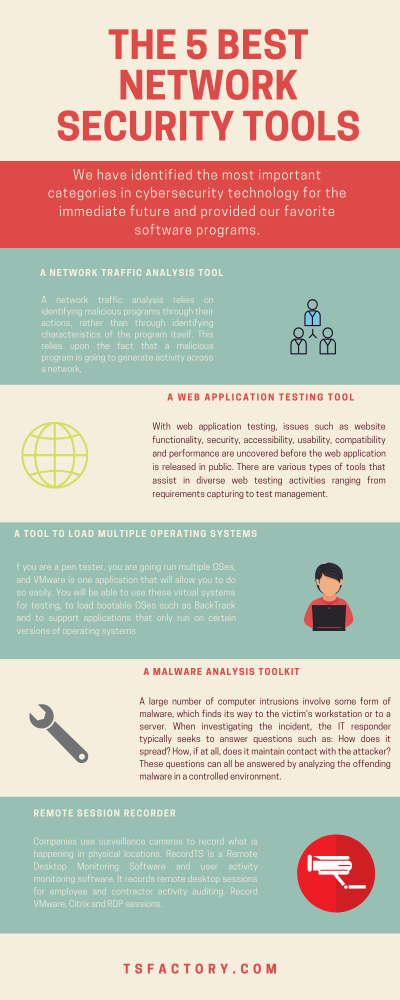
The 5 Best Network Security Tools
The 5 Best Network Security Tools
Threats are constantly evolving and, just like everything else, tend to follow certain trends. Whenever a new type of threat is especially successful or profitable, many others of the same type will inevitably follow. The best defenses need to mirror those trends so users get the most robust protection against the newest wave of threats. Along those lines, we have identified the most important categories in cybersecurity technology for the immediate future and provided our favorite software programs.
1. A malware analysis toolkit
A large number of computer intrusions involve some form of malicious software (malware), which finds its way to the victim’s workstation or to a server. When investigating the incident, the IT responder typically seeks to answer questions such as: What actions can the malware specimen perform on the system? How does it spread? How, if at all, does it maintain contact with the attacker? These questions can all be answered by analyzing the offending malware in a controlled environment.
Websites like virustotal.com and jotti.org allow you to scan a malicious file or URL against several different AV products. This provides a quick and easy way to determine if several different AV vendors have defined the software as malicious.
2. A network traffic analysis tool
A network traffic analysis relies on identifying malicious programs through their actions, rather than through identifying characteristics of the program itself. Network traffic analysis relies upon the fact that a malicious program is going to generate activity across a network, including the traffic originating from the network, coming into the network, and traversing laterally across a network. Network traffic analysis might be able to identify large numbers of files being uploaded or downloaded, files being moved, or files being encrypted at rates that are unusual.
We can recommend Microsoft Message Analyzer, the successor to Microsoft Network Monitor 3.4. It has an intuitive and flexible UI with effective filtering options that allow you to break down and drill into captured packets (or ‘messages’ as they are called in Message Analyzer). By adding ‘Color Rules’ to different protocol traffic, you can make scanning through areas of interest easier and faster.
GFI LanGuard can scan both small and large networks, in search of software vulnerabilities and unpatched or unlicensed applications. Information coming from up to 60,000 devices, running on Windows, Mac OS or Linux, will be shown in a centralized web console, so you’ll be able to see the state of your whole network at any moment and from any location.

3. A web application testing tool
With web application testing, issues such as website functionality, security, accessibility, usability, compatibility and performance are uncovered before the web application is released in public. They are various types of tools that assist in diverse web testing activities ranging from requirements capturing to test management.
Selenium is possibly the most popular open-source test automation framework for Web applications. Being originated in the 2000s and evolved over a decade, Selenium has been an automation framework of choice for Web automation testers, especially for those who possess advanced programming and scripting skills. Selenium has become a core framework for other open-source test automation tools such as Katalon Studio, Watir, Protractor, and Robot Framework.
Burp Suite is a complete package of tools designed to test the security of Web applications. It has the ability to act as a proxy server, a Web spider, an intruder and a repeater, and requests can be automated.
4. A tool to load multiple operating systems
If you are a pen tester, you are going run multiple OSes, and VMware is one application that will allow you to do so easily. You will be able to use these virtual systems for testing, to load bootable OSes such as BackTrack and to support applications that only run on certain versions of operating systems. VMware offers both paid and free versions of its products.
Citrix XenApp and Remote Desktop Services from Windows are also two popular alternatives.
5. Remote Session Recorder
Companies use surveillance cameras to record what is happening in physical locations. Now take that concept and apply it to your IT systems. Organizations of all sizes need to reduce the risk associated with insiders – whether it is an employee or a third party, accidental or intentional.
RecordTS is a Remote Desktop Monitoring Software and user activity monitoring software. It records remote desktop sessions for employee and contractor activity auditing. Record VMware, Citrix and RDP sessions.
Want to Know More?
Want to know one of the best ways to protect your network security?
Download a 30 day trial of RecordTS and begin recording and protecting your servers today.